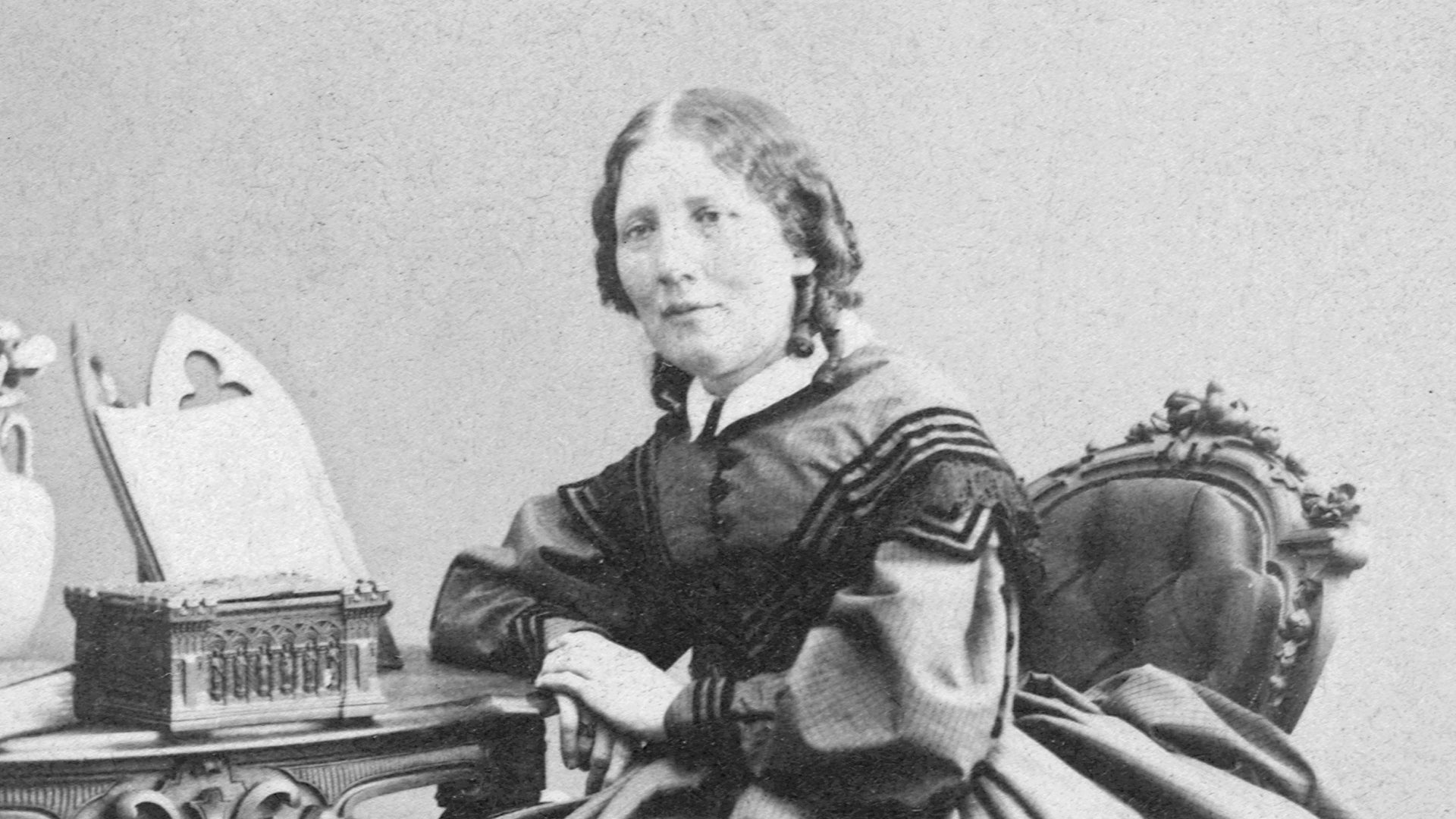ThIs Great War
“There is more done with pens than swords.” –Harriet Beecher Stowe
Extraordinary novels have had a global impact: John Steinbeck’s The Grapes of Wrath, Harper Lee’s To Kill a Mockingbird, and George Orwell’s 1984. Harriet Beecher Stowe’s Uncle Tom’s Cabin altered history as it helped ignite the American Civil War. To learn about the female great emancipator, follow the road to the Harriet Beecher Stowe Center.
A historic irony is how a girl from New England became a persona gratis in the theater of the South. Harriet Elisabeth was born in the small town of Litchfield, Connecticut, in 1811, the seventh child of Reverend Lyman Beecher. When his wife, Roxanna, was pregnant, Lyman had hoped for a son he would call Henry. Upon the arrival of a girl, he christened her Harriet, nicknamed Hatty. The mother of nine passed away at age forty-one from tuberculosis.
Hoping a change of scenery would abate his daughter’s grief, Lyman sent Harriet to relatives in Nut Plains, Connecticut. Her aunt, Harriet Foote, taught her women were the intellectual equals of men. A year later, Harriet rejoined her family.
Along with second wife Harriet Porter, with whom he had four children, and his nine from his first marriage, in 1832, the family moved to Cincinnati. He felt the city to be the moral equivalent of its first syllable, “sin” and believed it his duty to save its souls from the Catholics and the infidels. 
The twenty-one-year-old Harriet joined the Semi-Colons, a literary gathering held in her Uncle Samuel’s parlor. After the group praised her writing, her confidence soared. Another off shoot of the Semi-Colon was it introduced her to fellow New Englander Calvin Ellis Stowe, an impoverished biblical scholar. His late wife, Eliza–who had been Harriet’s friend–had died in the cholera epidemic. A smitten Harriet gushed, Calvin was “rich in Greek & Hebrew, Latin & Arabic, & alas, rich in nothing else…” Calvin and Harriet married in 1836, and the new Mrs. Stowe described life in their Walnut Hills home as “tranquil, quiet, and happy.” Twin daughters arrived who Harriet wished to name Eliza after Calvin’s first wife and Isabella. However, Calvin decided to honor both his former and present spouses and the final christening was Eliza Tyler and Harriet Beecher. Their other children: Henry Ellis who Harriet called “the lamb of my flock, Frederick William, Georgiana May, Samuel Charles, Charley, whose doting mother dubbed “my sunshine child,” and Charles Edward. To supplement their income, Harriet sold articles but lamented, “I am but a mere drudge with few ideas beyond babies and housekeeping.” Charley’s passing at eighteen months from cholera crushed his parents. Harriet mined her heartache in Uncle Tom’s Cabin to describe the pain mothers experienced when their masters sold their children. When Calvin became a professor at Bowdoin College in Maine, Harriet was grateful to return to New England in the hope a new environment would take the edge from her anguish.
Despite being overwhelmed with her children, Harriet was horrified over what the South referred to as their “peculiar little institution.” She expressed her outrage, “No one can have the system of slavery brought before him without an irrepressible desire to do something, and what is there to be done?” In answer to her question, Isabella Porter Beecher, her sister-in-law, suggested, “If I could use a pen as you can, Hatty, I would write something that would make this whole nation feel what an accursed thing slavery is.”
The impetus that led to the book that placed Harriet in the literary firmament was Congress’ 1850 Fugitive Slave Law that made Northerners implicit in slavery. Harriet’s response was to hide John Andrew Jackson who had fled South Carolina. She sent abolitionist essays to the magazine The National Era and wrote her publisher, “The time is come when even a woman or a child who can speak a word for freedom and humanity is bound to speak.”
The first segment appeared in the 1851 issue with the title, “Uncle Tom’s Cabin” by Mrs. H. B. Stowe. Shying from praise, Harriet claimed the idea descended while she was taking communion, that she did not so much write it as she received it from God. Boston-based John P. Jewett published the articles as a novel in 1852; it sold 10,000 copies the first week and 300,000 copies in its first year. In three months, Harriet earned $10,000, a staggering figure for its time. Translations appeared in more than forty languages, and Uncle Tom’s Cabin became the world’s second-best seller, after the Bible. A marketing bonanza led to toys, games, wallpapers, plates, and candlesticks. Although vilified in the South-threatening letters arrived in the Stowe mailbox- the housewife transformed into a celebrity author who preached from her paper pulpit. In England, her novel sold three times as many copies as it did in America, and Queen Victoria reported she had enjoyed Mrs. Stowe’s second book, Dred. At the invitation of anti-slavery European groups, Harriet visited Britain, France, Italy, and Switzerland.
Shortly after her return, a telegram informed her that her son, Henry, a student at Dartmouth College in New Hampshire, had drowned. A national tragedy followed the Stowe’s personal one with the outbreak of the Civil War. Consumed with trepidation of losing a third son, nevertheless, Harriet took Frederick, who had enlisted, to the New Jersey train depot. On New Year’s Day, 1863, in attendance at a concert at the Boston Music Hall, she heard the announcement President Lincoln had signed the Emancipation Proclamation. Aware the author was in the audience, shouts rang out, “Mrs. Stowe! Mrs. Stowe!”
As the war drew to its close, Calvin retired, and the Stowes built their forever home on Forest Street in Hartford, Connecticut, where Harriet spent her teenage years. At last, she had the leisure to garden and paint. Another activity was sharing her history with her son, Charles Edward, who published her autobiography. An ordained minister, he lived for a time with his wife and family in the Forest Street home. Hattie and Eliza never married and also lived with their parents. Georgina suffered from a morphine addiction that a doctor had prescribed as a painkiller after she gave birth. She passed away at age forty-seven. The Stowes’ youngest, Frederick William, dropped out of Harvard Medical School to enlist in the Union and suffered a wound at the Battle of Gettysburg. Empathetic to Frederick’s alcoholism, Harriet based her character, Tom Boulton, in “My Wife and I” after her suffering son. In a novel move for her era, Harriet portrayed addiction as an illness, rather than a moral failure. Frederick took off for California, where he was never heard from again. Three of the Stowes’ seven children outlived their parents.
In 1886, Calvin passed away, leaving his widow bereft. Another torment was she was aware of her diminishing mental state. She confided her great fear to a friend, “My mind wanders like a running brook. My sun has set. The time of work for me is over. I have written all my words and thought all my thoughts.” Descending into dementia, Harriet kept rewriting Uncle Tom’s Cabin. She also took to wandering the halls of her neighbor, famed writer Samuel Clemens, mistaking it for her own. At age eighty-five, Harriet passed away in her home. Her final resting place was in Andover, Massachusetts, in a plot between Calvin and Henry.
Harriet Beecher Stowe Center: Harriet’s forever home on 77 Forest Street is an expansive 1870s brick structure, built on a hillside near the grounds of a mental institution–thus the neighborhood name: Asylum Hill. The Center holds the largest collection of Harriet Beecher Stowe with 228,000 items. The dominant aspect of the house is the plethora of Uncle Tom’s Cabin memorabilia. During her European sojourn, admirers presented her with a twenty-six-volume petition supporting abolition, signed by 560,000 British women, currently on display. A primary source document is a runaway slave poster. A shocking artifact is a bracelet fashioned with links from a slave’s chains. A cache of letters bears the signatures: Henry Wadsworth Longfellow, Ralph Waldo Emerson, Elisabeth Cady Stanton, and Susan B. Anthony. The Center holds original and foreign editions of Stowe’s novels. On the dining room table, Harriet penned her history- making masterpiece. A handwritten page from Uncle Tom’s manuscript is located at the Center. Bright yellow women’s suffrage ribbons manifest the author’s feminist affiliation. Her upstairs office, lined in blue and gold wallpaper, was where she retired to mourn the loss of her daughter Georgina. The adjoining room was Calvin’s study. Early in their marriage, Harriet had persuaded her husband to provide her with a private space, “If I am to write, I must have a room to myself.” He did not have to be convinced as Calvin had always encouraged his wife’s writing, exhorting she “must be a literary woman.” Another room’s wallpaper is of images based on 1850s prints of scenes from Uncle Tom’s Cabin.
A popular anecdote concerning the diminutive author revolved around her 1862 visit to the White House. President Abraham greeted her, “So, you’re the little woman who wrote the book that started this great war.”
A View from Her Window
From her window, she must have marveled that she was the neighbor of Samuel Clemens with whom she took tea.
Nearby Attraction: The Mark Twain House & Museum
The Mark Twain House & Museum, in the zip code of Nook Farm, is a nineteen-room, 11,500 square-foot mansion, with floor coverings designed by Louis Comfort Tiffany.


